Effects of Boron and Zinc Micro-Fertilizer on Growth and Quality of Jujube Trees (Ziziphus jujuba) in the Desert Area
Abstract
1. Introduction
2. Materials and Methods
2.1. Site Description
2.2. Experimental Design
2.3. Measurement Indicators
2.3.1. Growth Index of Jujube Tree
2.3.2. Physiological Index of Jujube Tree
2.3.3. Quality Indexes of Jujubes
2.3.4. Water Use Efficiency
2.3.5. Physical and Chemical Properties of Soil
2.4. Photosynthetic Light Response Model
2.5. Statistical Analysis
3. Results
3.1. Effects of Boron and Zinc on the Growth Index of Jujube Tree
3.2. Effects of Boron and Zinc on Photosynthesis of Jujube Tree
3.2.1. Photoresponse Curve
3.2.2. Intercellular CO2 Concentration
3.2.3. Transpiration Rate
3.2.4. Stomatal Conductance
3.3. Effects of Boron and Zinc on Water Use Efficiency of Jujube Tree
3.3.1. Water Consumption Process of Jujubes
3.3.2. Yield
3.3.3. Water Use Efficiency (WUE)
3.4. Effect of Boron and Zinc on Quality of Red Jujube
3.4.1. Soluble Sugar
3.4.2. Titratable Acid
3.4.3. Flavone
3.5. Quantitative Relationship
4. Discussion
4.1. Growth Parameters
4.2. Yield
4.3. Quality
5. Conclusions
Supplementary Materials
Author Contributions
Funding
Data Availability Statement
Conflicts of Interest
References
- Chen, J.; Tsim, K.W.K. A Review of Edible Jujube, the Ziziphus Jujuba Fruit: A Heath Food Supplement for Anemia Prevalence. Front. Pharmacol. 2020, 11, 593655. [Google Scholar] [CrossRef]
- Xue, X.; Zhao, A.; Wang, Y.; Ren, H.; Li, Y.; Li, D.; Du, J. Metabolomics-based Analysis of Flavonoid Metabolites in Chinese Jujube and Sour Jujube Fruits from Different Harvest Periods. J. Food Sci. 2022, 87, 3752–3765. [Google Scholar] [CrossRef]
- Shen, L.-Y.; Luo, H.; Wang, X.-L.; Wang, X.-M.; Qiu, X.-J.; Liu, H.; Zhou, S.-S.; Jia, K.-H.; Nie, S.; Bao, Y.-T.; et al. Chromosome-Scale Genome Assembly for Chinese Sour Jujube and Insights Into Its Genome Evolution and Domestication Signature. Front. Plant Sci. 2021, 12, 773090. [Google Scholar] [CrossRef]
- Liu, Y.; Sang, Y.; Guo, J.; Zhang, W.; Zhang, T.; Wang, H.; Cheng, S.; Chen, G. Analysis of Volatility Characteristics of Five Jujube Varieties in Xinjiang Province, China, by HS-SPME-GC/MS and E-nose. Food Sci. Nutr. 2021, 9, 6617–6626. [Google Scholar] [CrossRef]
- Kaur, H.; Kaur, H.; Kaur, H.; Srivastava, S. The Beneficial Roles of Trace and Ultratrace Elements in Plants. Plant Growth Regul. 2023, 100, 219–236. [Google Scholar] [CrossRef]
- Liu, W.; Yang, X.; Duan, L.; Naidu, R.; Yan, K.; Liu, Y.; Wang, X.; Gao, Y.; Chen, Y. Variability in Plant Trace Element Uptake across Different Crops, Soil Contamination Levels and Soil Properties in the Xinjiang Uygur Autonomous Region of Northwest China. Sci. Rep. 2021, 11, 2064. [Google Scholar] [CrossRef]
- Mangrio, N.; Kandhro, M.N.; Soomro, A.A.; Mari, N.; Shah, Z.-H. Growth, Yield and Sucrose Percent Response of Sugarcane to Zinc and Boron Application. Sarhad J. Agric. 2020, 36, 459–469. [Google Scholar] [CrossRef]
- Kohli, S.K.; Kaur, H.; Khanna, K.; Handa, N.; Bhardwaj, R.; Rinklebe, J.; Ahmad, P. Boron in Plants: Uptake, Deficiency and Biological Potential. Plant Growth Regul. 2023, 100, 267–282. [Google Scholar] [CrossRef]
- Singh, A.K.; Singh, A.K.; Singh, J.P. Boron in Crop Production from Soil to Plant System: A Review. Arch. Agric. Environ. Sci. 2020, 5, 218–222. [Google Scholar] [CrossRef]
- Day, S.; Aasim, M. Role of Boron in Growth and Development of Plant: Deficiency and Toxicity Perspective. In Plant Micronutrients; Springer International Publishing: Cham, Switzerland, 2020; pp. 435–453. [Google Scholar]
- Naeem, M.; Ansari, A.A.; Gill, S.S. Essential Plant Nutrients: Uptake, Use Efficiency, and Management; Springer: New York, NY, USA, 2017; ISBN 3319588419. [Google Scholar]
- Priadkina, G.O. Influence of Trace Elements, Applied in Classical and Nano Forms, on Photosynthesis of Higher Plants in Relation to Enhancement of Crop Productivity. Agric. Sci. Pract. 2020, 7, 71–85. [Google Scholar] [CrossRef]
- Wyszkowski, M.; Brodowska, M.S. Content of Trace Elements in Soil Fertilized with Potassium and Nitrogen. Agriculture 2020, 10, 398. [Google Scholar] [CrossRef]
- Rizwan, M.; Ali, S.; Rehman, M.Z.; Rinklebe, J.; Tsang, D.C.W.; Tack, F.M.G.; Abbasi, G.H.; Hussain, A.; Igalavithana, A.D.; Lee, B.C.; et al. Effects of Selenium on the Uptake of Toxic Trace Elements by Crop Plants: A Review. Crit. Rev. Environ. Sci. Technol. 2021, 51, 2531–2566. [Google Scholar] [CrossRef]
- Tkachenko, K.; Frontasyeva, M.; Vasilev, A.; Avramov, L.; Shi, L. Major and Trace Element Content of Tribulus terrestris L. Wildlife Plants. Plants 2020, 9, 1764. [Google Scholar] [CrossRef]
- Qing, L.; Zhongrun, N.; Shenli, W.; Huang, H.; Jin, W.; Zhou, T. Spatial Distribution Characteristics of Avaiable Microelement Cotents in Oasis Copland Soils of Arid Areas. Res. Environ. Sci. 2011, 24, 273–280. [Google Scholar]
- Song, J.; Lv, T.; Zhang, B. Effects of Drip Irrigation Amount on Growth and Soil Moisture of Jun Jujube in Different Growth Stages in Southern Xinjiang. Water Sav. Irrig. 2022, 98–102. [Google Scholar] [CrossRef]
- Tang, R.; Dong, S.; Zhang, M.; Zhou, Z.; Zhang, C.; Li, P.; Bai, M. Hydrochemical Characteristics and Water Quality of Shallow Groundwater in Desert Area of Kunyu City, Southern Margin of Tarim Basin, China. Water 2023, 15, 1563. [Google Scholar] [CrossRef]
- Yao, K.; Halike, A.; Chen, L.; Wei, Q. Spatiotemporal Changes of Eco-Environmental Quality Based on Remote Sensing-Based Ecological Index in the Hotan Oasis, Xinjiang. J. Arid Land 2022, 14, 262–283. [Google Scholar] [CrossRef]
- Zhou, S.; Sun, S.; Yao, B.; Li, F.; He, T.; Wang, W. Effects of Mist Irrigation on Canopy Environment, Photosynthetic Characteristics, Yield and Quality of Jujube Orchard. Trans. Chin. Soc. Agric. Mach. 2021, 52, 249–257. [Google Scholar]
- Liu, L.; Zhang, J.X.; Jin, S.S.; Sun, B.; Dong, J.G.; Wang, Y.K. Characteristics of Water Consumption of Jujube Forests with Limited Growth. Agric. Res. Arid Areas 2019, 37, 10–15+25. [Google Scholar] [CrossRef]
- Shang, B.; Zheng, B.; Zhou, Z.; Wang, L. Spatial Heterogeneity of Soil Organic Matter in Mayi Lake Area of Karamay City. J. South China Agric. Univ. 2020, 42, 72–81. [Google Scholar]
- Qiao, C.; Yang, Y.; Wamg, D.; Yang, S. Effect of Soil PH on Soil Physico-Chemical Properties and Population Dynamics of Fecal Escherichia Coli in Soil Combined with Biogas Slurry. Soil Fertil. Sci. China 2023, 61–66. [Google Scholar]
- Duo, A.; Zhao, W.; Gong, Z.; Zhang, M.; Fan, Y. Temporal Analysis of Climate Change and Its Relationship with Vegetation Cover on the North China Plain from 1981 to 2013. Shengtai Xuebao/Acta Ecol. Sin. 2017, 37, 576–592. [Google Scholar] [CrossRef]
- Thornley, J.H.M. Mathematical Models in Plant Physiology; Academic Press (Inc.), Ltd.: London, UK, 1976; pp. 56–78. ISBN 0126905509. [Google Scholar]
- Wu, X.; Liu, G.; Riaz, M.; Yan, L.; Jiang, C. Metabolic Changes in Roots of Trifoliate Orange [Poncirus trifoliate (L.) Raf.] as Induced by Different Treatments of Boron Deficiency and Resupply. Plant Soil 2019, 434, 217–229. [Google Scholar] [CrossRef]
- Arough, Y.K.; Sharifi, R.S.; Sedghi, M.; Barmaki, M. Effect of Zinc and Bio Fertilizers on Antioxidant Enzymes Activity, Chlorophyll Content, Soluble Sugars and Proline in Triticale under Salinity Condition. Not. Bot. Horti Agrobot. Cluj-Napoca 2016, 44, 116–124. [Google Scholar] [CrossRef][Green Version]
- Abd El-wahed, A.E.N.; Khalifa, S.M.; Alqahtani, M.D.; Abd–Alrazik, A.M.; Abdel-Aziz, H.; Mancy, A.; Elnaggar, I.A.; Alharbi, B.M.; Hamdy, A.; Elkelish, A. Nano-Enhanced Growth and Resilience Strategies for Pomegranate Cv. Wonderful: Unveiling the Impact of Zinc and Boron Nanoparticles on Fruit Quality and Abiotic Stress Management. J. Agric. Food Res. 2024, 15, 100908. [Google Scholar] [CrossRef]
- Xie, R.; Zhao, J.; Lu, L.; Ge, J.; Brown, P.H.; Wei, S.; Wang, R.; Qiao, Y.; Webb, S.M.; Tian, S. Efficient Phloem Remobilization of Zn Protects Apple Trees during the Early Stages of Zn Deficiency. Plant. Cell Environ. 2019, 42, 3167–3181. [Google Scholar] [CrossRef]
- Swietlik, D. Zinc Nutrition of Fruit Crops. Horttechnology 2002, 12, 45–50. [Google Scholar] [CrossRef]
- Seraji, E.; Shivanna; Honnabyraiah, M.; Dhananjaya, M.K.; Venkata Rao, B.N.; Premalatha, B.R. Effect of Foliar Application of Zinc and Boron from Different Sources on Growth, Yield and Quality of Custard Apple (Annona squamosa L.) Cv. Arka Sahan. IJCS 2020, 8, 35–39. [Google Scholar]
- Meena, K.; Verma, R.S.; Singh, V.; Shivra, B.C.; Meena, S.; Diwakar, N. Effect of Zinc and Boron on Growth, Yield and Quality of Guava (Psidium guajava L.) Cv. L-49. Int. J. Plant Soil Sci. 2023, 35, 98–103. [Google Scholar] [CrossRef]
- Din, S.; Ahmad, F.; Perveen, A.; Manan, M. Effect of Exogenous Application of Boron and Zinc with or without Added Urea on the Yield and Nutrient Assimilation of Cotton. Pakistan Cott. 2014, 56, 24–34. [Google Scholar]
- Shahgholi, S.; Sayfzadeh, S.; Hadidi Masouleh, E.; Shahsavari, N.; Zakerin, H. Assessment of Zinc, Boron, and Iron Foliar Application on Wheat Yield and Yield Components Under Drought Stress. Commun. Soil Sci. Plant Anal. 2023, 54, 1283–1292. [Google Scholar] [CrossRef]
- Ullah, S.; Khan, A.S.; Malik, A.U.; Afzal, I.; Shahid, M.; Razzaq, K. Floiar Application of Boron Influences the Leaf Mineral Status, Vegetative and Reproductive Growth, Yield and Fruit Quality of “Kinnow” Mandarin (Citurs Reticulata Blanco.). J. Plant Nutr. 2012, 35, 2067–2079. [Google Scholar] [CrossRef]
- Ferreira, G.A.; Hippler, F.W.R.; Prado, L.A.d.S.; Rima, J.A.H.; Boaretto, R.M.; Quaggio, J.A.; Façanha, A.R.; Mattos, D., Jr. Boron Modulates the Plasma Membrane H + - ATPase Activity Affecting Nutrient Uptake of Citrus Trees. Ann. Appl. Biol. 2021, 178, 293–303. [Google Scholar] [CrossRef]
- Meriño-Gergichevich, C.; Luengo-Escobar, A.; Alarcón, D.; Reyes-Díaz, M.; Ondrasek, G.; Morina, F.; Ogass, K. Combined Spraying of Boron and Zinc During Fruit Set and Premature Stage Improves Yield and Fruit Quality of European Hazelnut Cv. Tonda Di Giffoni. Front. Plant Sci. 2021, 12, 661542. [Google Scholar] [CrossRef] [PubMed]
- Ödemiş, B.; Uncu, S. Determining Effects of Foliar Boron Applications on Yield and Fruit Quality of Apricot Trees for Reducing Water Stress. Mustafa Kemal Üniversitesi Tarım Bilim. Derg. 2022, 27, 47–60. [Google Scholar] [CrossRef]
- Safdar, M.E.; Qamar, R.; Javed, A.; Nadeem, M.A.; Javeed, H.M.R.; Farooq, S.; Głowacka, A.; Michałek, S.; Alwahibi, M.S.; Elshikh, M.S.; et al. Combined Application of Boron and Zinc Improves Seed and Oil Yields and Oil Quality of Oilseed Rape (Brassica napus L.). Agronomy 2023, 13, 2020. [Google Scholar] [CrossRef]
- Michailidis, M.; Bazakos, C.; Kollaros, M.; Adamakis, I.S.; Ganopoulos, I.; Molassiotis, A.; Tanou, G. Boron Stimulates Fruit Formation and Reprograms Developmental Metabolism in Sweet Cherry. Physiol. Plant. 2023, 175. [Google Scholar] [CrossRef]
- Panjikar, M.; Prasad, R.E.; Moses, S. To Study the Assessment of Foliar Spray of Boron and Zinc in Tomato for Higher Yield and Quality Improvement. Pharma Innov. J. 2023, 12, 1761–1763. [Google Scholar]
- Zhang, Y.; Song, H.; Xue, Z.; Niu, P.; Jie, L.; Li, C. Effects of Zinc and Boron Rate on Ear-Kernel Traits and Grain Quality in Mazie. J. Nucl. Agric. Sci. 2004, 31, 371–378. [Google Scholar]
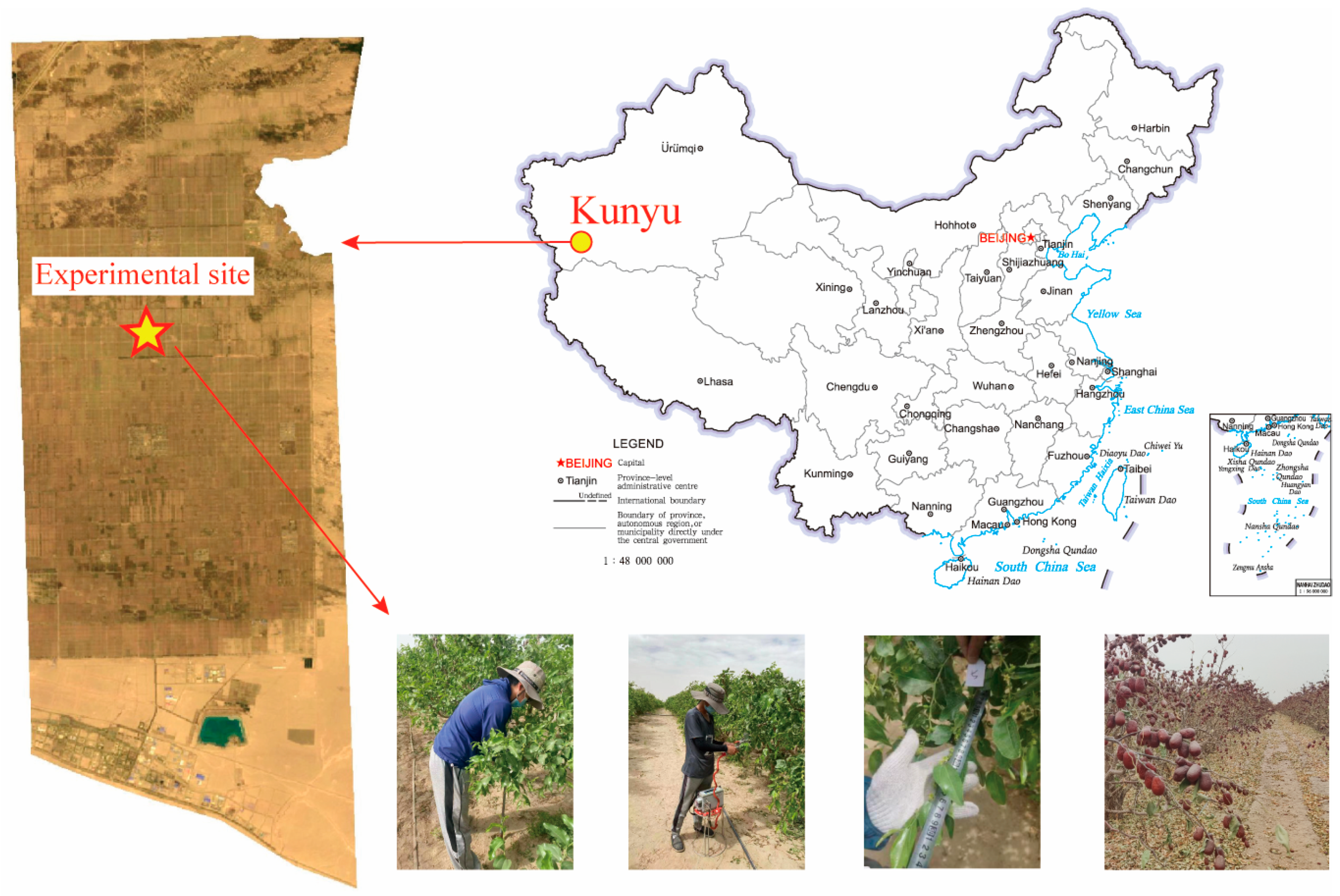

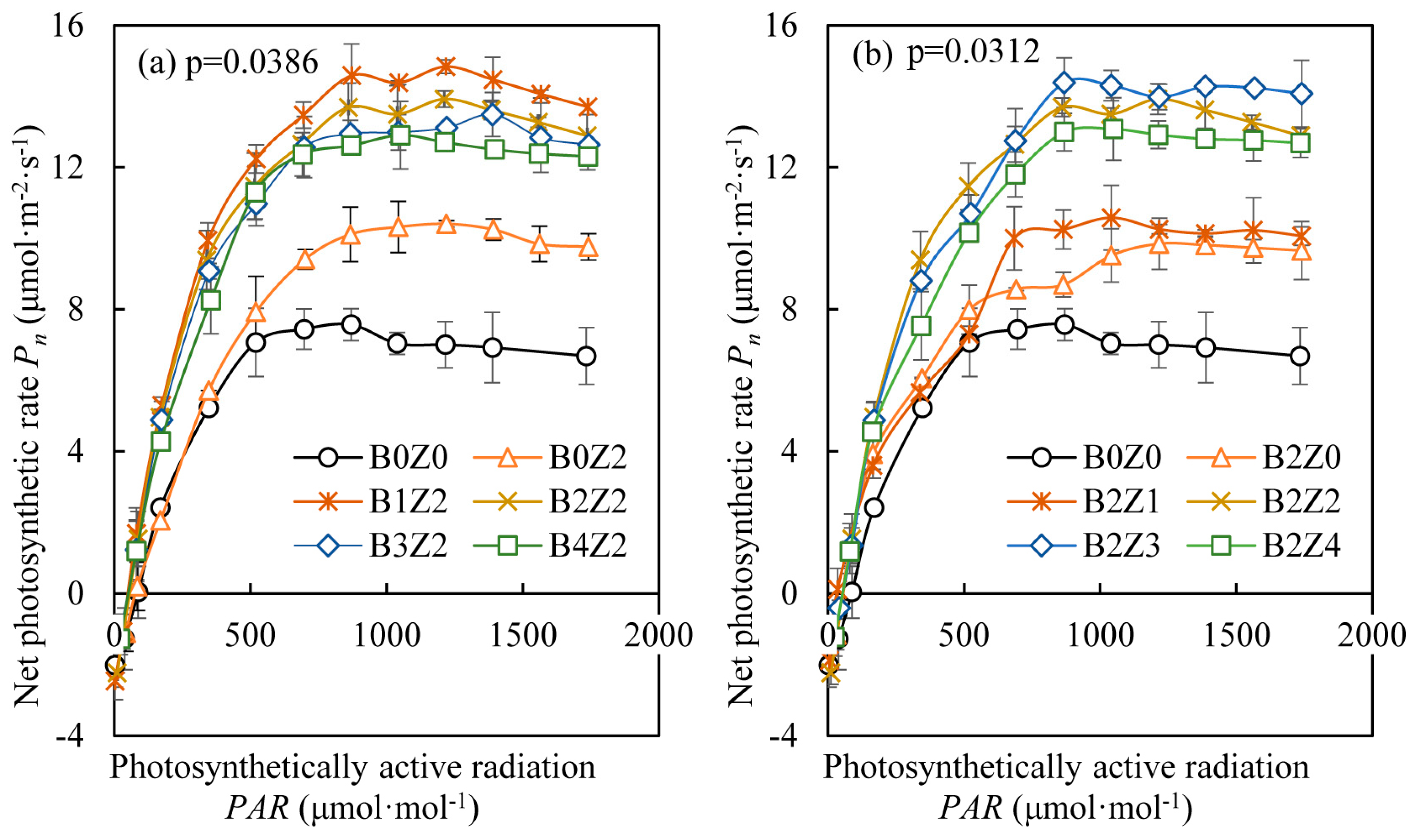
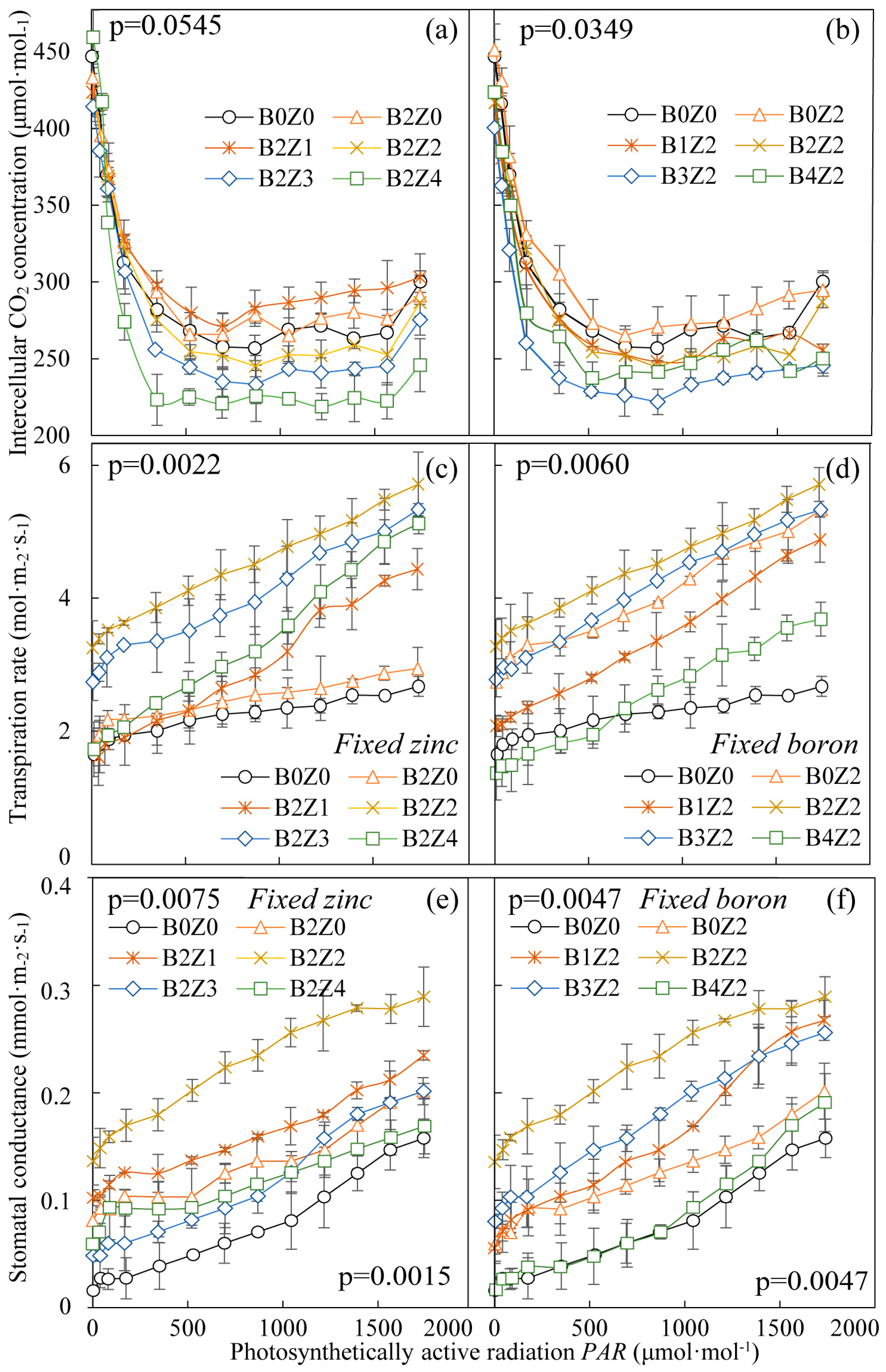
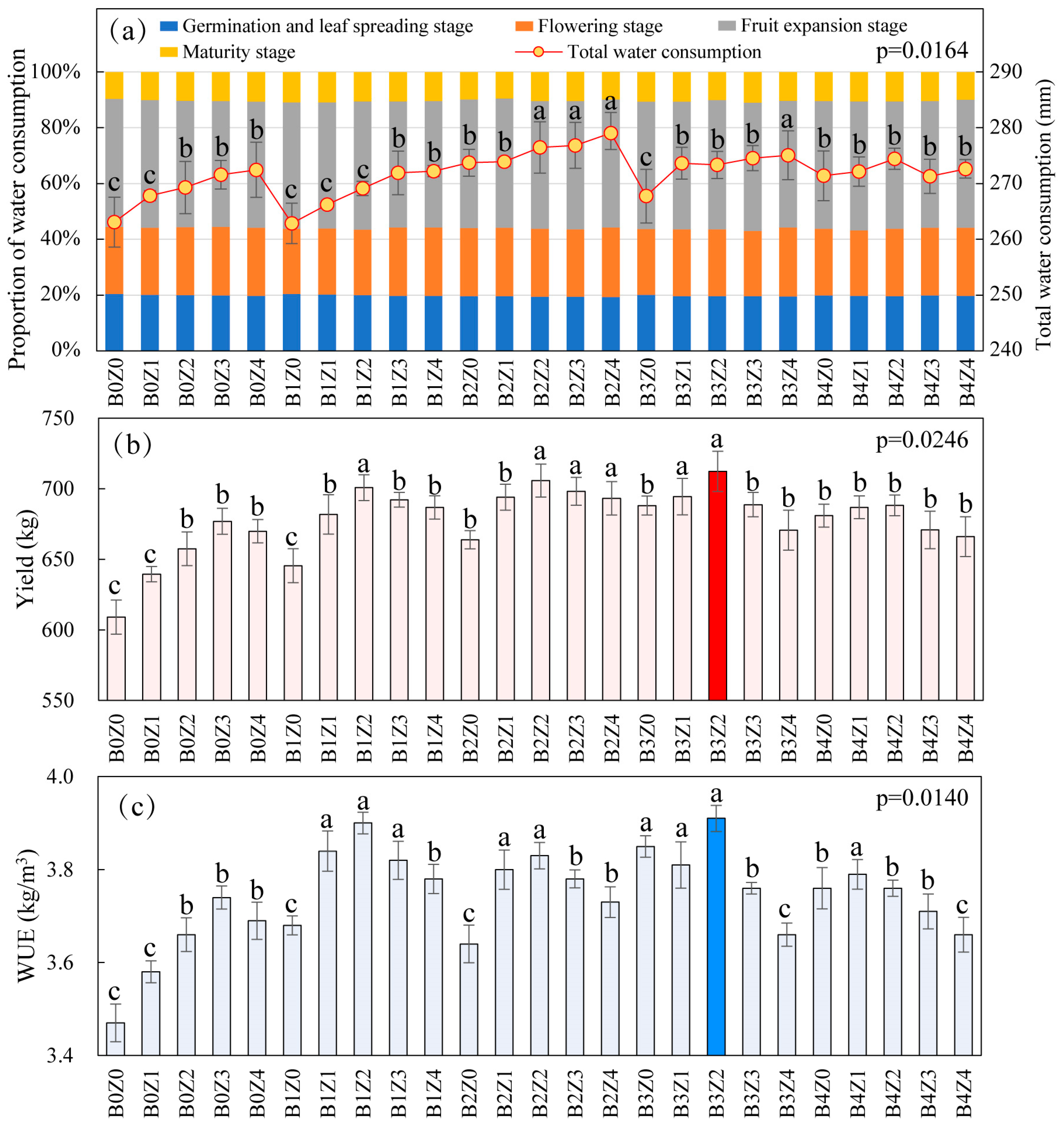
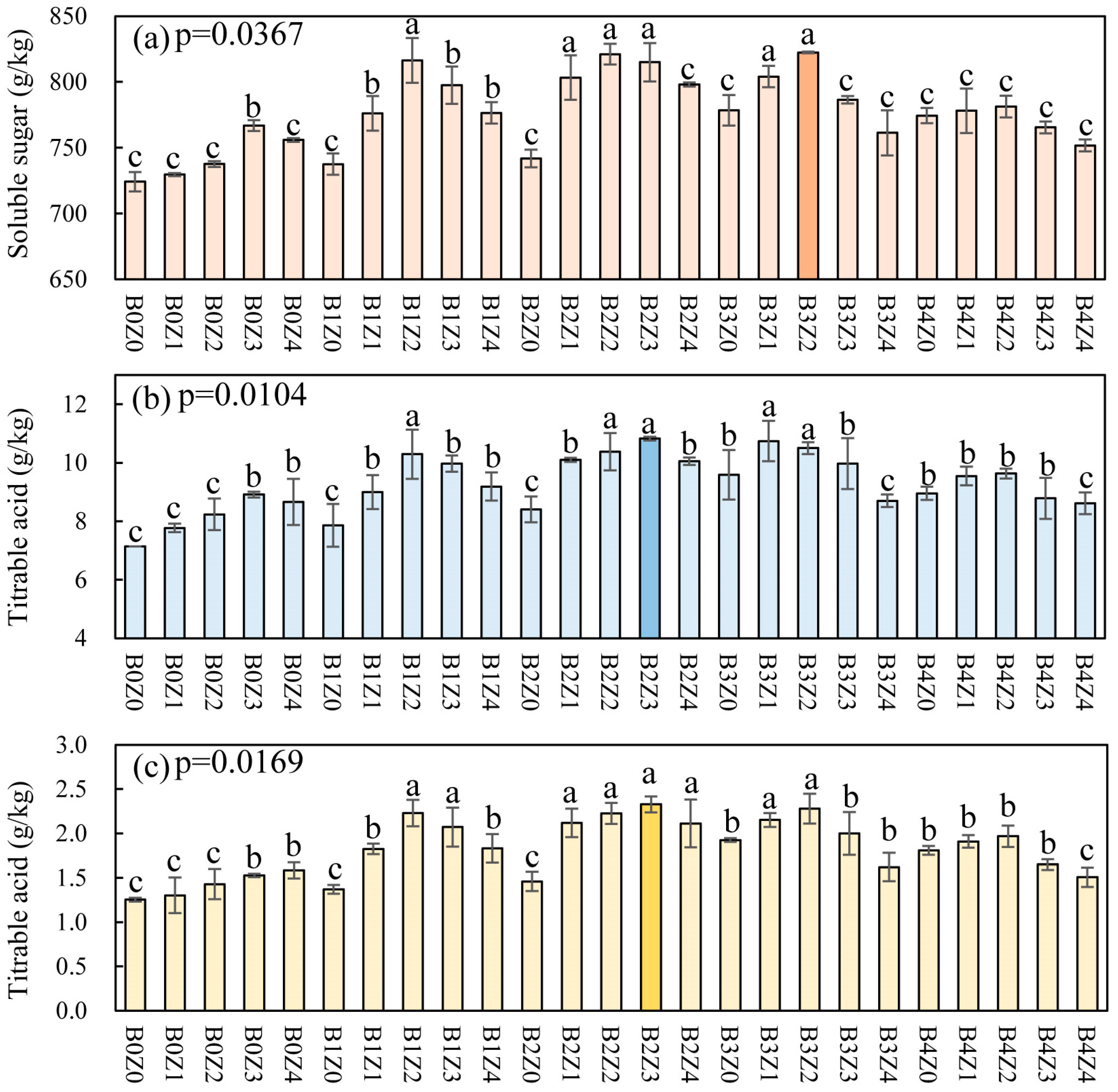

| Treatment | α | Pnmax/ µmol·m−2·s−1 | Rd /µmol·m−2·s−1 | LCP/ µmol·m−2·s−1 | LST/ µmol·m−2·s−1 | R2 | |
|---|---|---|---|---|---|---|---|
| CK | B0Z0 | 0.0231 ± 0.0025 | 9.11 ± 0.34 a | 1.99 ± 0.26 | 86.32 ± 4.91 | 480.11 ± 14.29 | 0.99 |
| Fixedzinc | B0Z2 | 0.0228 ± 0.0017 | 12.30 ± 0.34 a | 1.92 ± 0.21 | 84.95 ± 4.87 | 624.04 ± 14.29 | 0.996 |
| B1Z2 | 0.0279 ± 0.0036 | 14.40 ± 0.69 a | 1.38 ± 0.30 | 50.15 ± 2.58 | 564.54 ± 18.33 | 0.994 | |
| B2Z2 | 0.0459 ± 0.0051 | 17.35 ± 0.61 a | 2.38 ± 0.38 | 52.81 ± 1.19 | 430.21 ± 12.42 | 0.994 | |
| B3Z2 | 0.0365 ± 0.0036 | 14.98 ± 0.49 b | 1.49 ± 0.30 | 41.35 ± 4.20 | 451.97 ± 17.04 | 0.995 | |
| B4Z2 | 0.0292 ± 0.0018 | 13.91 ± 0.32 b | 1.17 ± 0.22 | 40.32 ± 4.39 | 517.04 ± 16.36 | 0.996 | |
| Fixed boron | B2Z0 | 0.0435 ± 0.0058 | 12.87 ± 0.46 a | 1.93 ± 0.24 | 48.00 ± 2.38 | 340.29 ± 14.23 | 0.99 |
| B2Z1 | 0.0294 ± 0.0071 | 12.76 ± 1.02 a | 1.50 ± 0.51 | 52.07 ± 4.46 | 484.30 ± 16.16 | 0.98 | |
| B2Z2 | 0.0459 ± 0.0051 | 17.35 ± 0.61 a | 2.38 ± 0.38 | 52.81 ± 3.33 | 430.21 ± 18.96 | 0.99 | |
| B2Z3 | 0.0251 ± 0.0029 | 14.79 ± 0.70 b | 1.59 ± 0.43 | 63.37 ± 4.95 | 651.49 ± 15.02 | 0.98 | |
| B2Z4 | 0.0404 ± 0.0056 | 17.37 ± 0.80 b | 1.94 ± 0.40 | 49.16 ± 2.67 | 477.95 ± 13.36 | 0.99 | |
Disclaimer/Publisher’s Note: The statements, opinions and data contained in all publications are solely those of the individual author(s) and contributor(s) and not of MDPI and/or the editor(s). MDPI and/or the editor(s) disclaim responsibility for any injury to people or property resulting from any ideas, methods, instructions or products referred to in the content. |
© 2024 by the authors. Licensee MDPI, Basel, Switzerland. This article is an open access article distributed under the terms and conditions of the Creative Commons Attribution (CC BY) license (https://creativecommons.org/licenses/by/4.0/).
Share and Cite
Tao, W.; Zeng, S.; Yan, K.; Alwahibi, M.S.; Shao, F. Effects of Boron and Zinc Micro-Fertilizer on Growth and Quality of Jujube Trees (Ziziphus jujuba) in the Desert Area. Agronomy 2024, 14, 741. https://doi.org/10.3390/agronomy14040741
Tao W, Zeng S, Yan K, Alwahibi MS, Shao F. Effects of Boron and Zinc Micro-Fertilizer on Growth and Quality of Jujube Trees (Ziziphus jujuba) in the Desert Area. Agronomy. 2024; 14(4):741. https://doi.org/10.3390/agronomy14040741
Chicago/Turabian StyleTao, Wanghai, Senlin Zeng, Kuihao Yan, Mona S. Alwahibi, and Fanfan Shao. 2024. "Effects of Boron and Zinc Micro-Fertilizer on Growth and Quality of Jujube Trees (Ziziphus jujuba) in the Desert Area" Agronomy 14, no. 4: 741. https://doi.org/10.3390/agronomy14040741
APA StyleTao, W., Zeng, S., Yan, K., Alwahibi, M. S., & Shao, F. (2024). Effects of Boron and Zinc Micro-Fertilizer on Growth and Quality of Jujube Trees (Ziziphus jujuba) in the Desert Area. Agronomy, 14(4), 741. https://doi.org/10.3390/agronomy14040741






